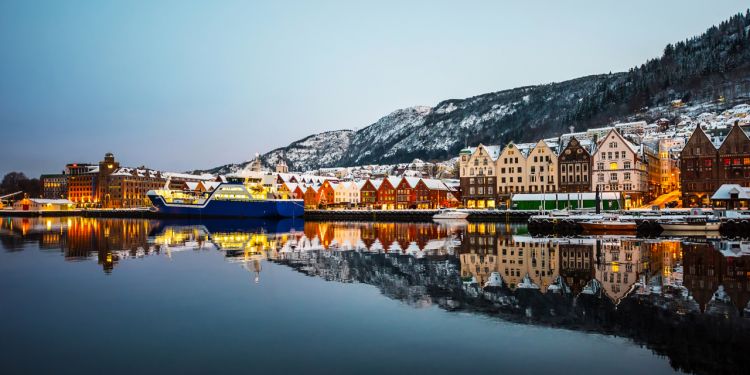
You've made the big decision to move to Norway! From breathtaking fjords to an exceptional quality of life, this Nordic dream is within reach. Yet, finding the right accommodation can be daunting. Fear not—this comprehensive guide covers housing types, expat-friendly neighborhoods, rental costs, and essential formalities. Whether you're budget-conscious or seeking luxury, these tips will help you find your perfect home in Norway.
Types of accommodation in Norway
Apartments (Leiligheter)
Modern Norwegian apartments come with contemporary kitchens, bathrooms, and often balconies or terraces. Many include essential appliances, and heated bathroom floors are a popular feature for added winter comfort. Sizes typically range from 50 to 80 square meters, though units in high-demand areas like Oslo may be smaller.
Apartments are the most prevalent type of housing, particularly in major cities like Oslo. Options vary from compact studios (enkel leilighet) to spacious multi-bedroom accommodations.
Studios (hybel) are compact single-room apartments, with a combined kitchenette and bathroom—ideal for students and young professionals due to affordability.
Careful with so-called basement apartments (sokkelleilighet) which are in fact lower-level units in houses, like basements, and cost-effective, offering privacy but limited natural light. This practice is common in high-demand cities like Oslo. Basement apartments can be a practical choice for initial accommodations, particularly if you're on a tight budget.
Detached houses (enebolig)
Found primarily in suburban and rural areas, detached houses offer privacy, spacious layouts, and gardens, making them ideal for families.
House share (bofellesskap)
Popular among students and young professionals in Norway, particularly in cities like Oslo and Bergen, house-sharing is economical in terms of rent and public service fees. Monthly rent for a room ranges from 6,000–8,000 NOK (around 500–700 euros) in Oslo and 5,000–8,000 NOK (around 400–700 euros) in Bergen.
Semi-detached houses (tomannsbolig)
Shared by two or more families with separate entrances, these semi-detached houses strike a balance between affordability and space and are a popular option in the suburbs.
Rental costs in Norway
Oslo rates
As the dynamic capital city, Oslo combines a vibrant urban lifestyle with numerous job, cultural and educational opportunities, but is Norway's priciest city for housing.
- Average rents: Budget 12,000–20,000 NOK/month (1,000–1,700 EUR) for 1-bedroom apartments in the city center, or a little less in the suburbs; around 15,000 NOK/month (1,350 EUR) for studios; and 25,000 NOK/month (2,150 EUR) for 2-bedroom apartments.
- Popular neighborhoods: Grünerløkka, Majorstuen, Frogner, and Aker Brygge (among the priciest of the favored areas). Most neighborhoods experience some degree of gentrification, particularly in the Old Town (Gamle Oslo), and typically provide a high standard of living.
- Popular suburbs: Baerum, Asker, and Nesodden.
Bergen rates
Bergen, Norway's second-largest city, is especially popular among expats employed in the energy, marine, and scientific sectors. Its surrounding majestic mountains and picturesque fjords offer an outstanding living environment.
- Average rents: Budget 9,000–15,000 NOK/month (800–1,300 EUR) for 1-bedroom apartments in the city center; around 10,000 NOK/month (850 EUR) for studios; around 15,000 NOK/month (1,275 EUR) for 2-bedroom apartments; and between 20,000–25,000 NOK/month (1,700–2,125 EUR) for a house.
- Popular areas: Nordnes, Sandviken, and Sentrum are sought-after neighborhoods celebrated for their historic charm and convenient access to amenities.
Trondheim rates
Home to NTNU University, Trondheim is a hub for research and innovation. Its smaller size and lower prices compared to Oslo upkeep its appeal to expats.
- Average rents: around 8,000–13,000 NOK/month for 1-bedroom apartments.
- Popular neighborhoods: Bakklandet, Møllenberg, and Sentrum are popular neighborhoods known for their student atmosphere and proximity to the university.
Stavanger rates
Known as Norway's oil capital, Stavanger is small but internationally diverse, and home to numerous expats employed in the energy industry.
- Average rates: 10,000–18,000 NOK/month for 1-bedroom apartments; 11,289 NOK/month (around 950 EUR) for city studios; around 14,000 NOK/month (1,180 EUR) for 2-bedroom apartments; and between 18,000–22,000 NOK/month (1,520–1,860 EUR) for a house.
- Popular areas: Eiganes, Våland, and Sentrum.
Tromsø rates
Above the Arctic Circle, Tromsø boasts a quality university and superior scientific research, thereby attracting adventurers and researchers despite its remoteness and cold weather.
- Average rents: 7,000–12,000 NOK/month for 1-bedroom apartments; around 10,189 NOK (approx. 860 EUR) for city studios; around 13,000 NOK/month (1,100 EUR) for 2-bedroom apartments; and between 18,000–22,000 NOK/month (1,520–1,9450 EUR) for a house.
- Popular neighborhoods: Sentrum and Tromsdalen for quick access to university and commodities.
Rental conditions and formalities in Norway
Rental agreements
In Norway, rental contracts are usually for a one-year term, with automatic renewals. The agreement must be in writing and include key details, such as the rent amount, payment schedule, and termination conditions.
- Fixed-term contracts: A fixed-term lease (typically one year, though it may vary depending on the agreement between the tenant and landlord), often used for temporary or seasonal rentals.
- Open-ended contracts: The lease continues until either party terminates it.
Security deposits
Landlords usually require a security deposit of up to three months' rent, held in a separate account and refunded after the tenancy upon satisfactory property inspection at the lease end.
Home insurance
While not mandatory in Norway, home insurance is highly recommended to cover property damage and personal belongings in cases like fire or theft.
Lease termination
A written three-month notice is standard to end a lease. A written three-month notice is standard. Early termination may incur fees to cover rent for the remaining term unless a new tenant is secured or you help facilitate this process. In any case, it's important to communicate openly and plan your departure well in advance.
What to do in case of a rental dispute in Norway
If you find yourself in a rental dispute in Norway, it's best to start by communicating directly with the landlord to attempt to resolve the issue. If this fails, tenants can turn to Husleietvistutvalget (HTU), an official mediation body that handles rental disputes in areas like Oslo and Tromsø. For areas not covered by the HTU, the Forliksrådet (conciliation court) can handle smaller disputes. Additionally, some home insurance policies offer legal protection in the event of a dispute. Finally, the Leieboerforeningen Association can provide valuable guidance and assist tenants in defending their rights.
House hunting in Norway
Online platforms
Real estate websites are the most efficient way to find housing in Norway. Here are some of the most popular options:
- Finn.no: The largest platform for rental listings nationwide.
- Hybel.no: Specializes in shared housing and studio rentals – ideal for students and young professionals.
- Zanussi.no: Features rental and purchase options.
Real estate agencies
Real estate agencies in Norway are ideal for personalized assistance. They provide complete, tailored services, including house hunting, contract negotiation, and administrative support.
Networking
Leverage professional and personal connections as well as expat groups on platforms like Facebook and LinkedIn to procure advice and recommendations. Networking, especially in the big high-demand cities, is a major tool to uncover hidden rental opportunities in Norway.
Expat groups and forums
Numerous online groups and forums cater to expats in Norway, offering valuable insider tips and recommendations, and even housing opportunities shared by other expats. Additionally, consider conducting your searches in English or exploring Norwegian Facebook communities for the Oslo region. Some listings may not appear on Finn.no. For instance, the group Leie og utleie Oslo og Akershus is worth checking out.
Housing crisis in Norway
Norway, much like other European countries, is grappling with a housing crisis. Over the past decade, rental prices have surged, particularly in major cities like Oslo. High demand for rental properties coupled with a limited supply of new housing has intensified the issue. Young adults, students, and expats are among the most affected groups. The situation is further exacerbated by fluctuating construction costs and restrictive urban planning policies. For newcomers and low-income residents, navigating this challenging landscape presents significant hurdles.
Tips for finding affordable accommodation in Norway
Choosing more affordable neighborhoods or areas outside urban centers
As you've likely realized, purchasing property in Norway is becoming increasingly challenging, so thorough research is essential to improve your chances of becoming a homeowner. Many Norwegians, particularly those in Oslo, often need to reconsider their preferred neighborhoods when searching for housing.
Suburban areas around major cities or smaller towns like Tromsø or Kristiansand often offer more affordable rental options. Focus on accommodations in areas well-served by public transport but situated away from city centers.
Consider smaller cities and suburbs where rental costs are typically lower. Public transport in major cities is generally reliable and efficient, allowing you to explore housing options in outlying areas or neighboring municipalities without compromising accessibility.
For example, towns such as Drammen, near Oslo, and Sandnes, close to Stavanger, offer more budget-friendly housing options while remaining well-connected to larger urban centers.
Choosing shared housing
Shared housing is a cost-effective option that significantly cuts down on living costs by sharing expenses. It also provides a great opportunity to connect with others and ease your transition into life in Norway.
Negotiating rent
Rent negotiation can sometimes be an option, particularly if you're prepared to commit to a long-term lease or if the property has been listed for an extended period. If you've noticed minor issues in the property or are willing to handle small repairs yourself, it's worth requesting a discount. However, in Oslo and its surrounding areas, the high demand and intense competition make negotiations less feasible. Attempting to negotiate in such areas could potentially cost you the opportunity. Carefully weigh the risks before negotiating and consider seeking input from locals to make an informed decision.
Taking advantage of student housing opportunities
As a student, housing provided by Norwegian universities and student organizations (such as dormitories) is often more affordable than private rentals. These options are typically well-located, close to campuses, and often include utilities in the rent, making them a cost-effective choice.
Considering furnished housing
Furnished apartments are relatively rare in Norway. Although they may appear pricier upfront, they can offer long-term savings as you won't need to buy furniture or appliances. Moreover, they provide greater flexibility for those planning short-term stays or frequent relocations in Norway.
Utilizing local networks and social media
Along with online search platforms, social networks and local groups are valuable resources for finding more affordable rentals, often before they are publicly listed. Joining expat groups or local forums can provide access to off-market housing opportunities through word-of-mouth referrals.
Flexibility with your housing criteria
If you're working with a limited budget, being flexible on factors like apartment size or exact location can make a big difference. Opting for a smaller apartment or a neighborhood a slightly farther from the city center can lead to significant savings without compromising your quality of life.
Buying property in Norway
Foreigners can buy property in Norway, as the real estate market is stable and interest rates are relatively attractive. However, it's important to note a key feature of the Norwegian property market: properties are often sold at auction after a period of open viewings, so it's crucial to be prepared to act quickly. Before bidding, ensure that you have the full amount of funds required.
As a buyer, you will also need to register with the land registry and obtain a Norwegian identification number. Additional costs, such as registration fees and legal fees, may apply to the purchase price.
If you're unfamiliar with the country's real estate process, hiring a local real estate agent can be a good idea. They will assist with the sale, manage the documentation, and guide you through the necessary procedures.
We do our best to provide accurate and up to date information. However, if you have noticed any inaccuracies in this article, please let us know in the comments section below.












Comments